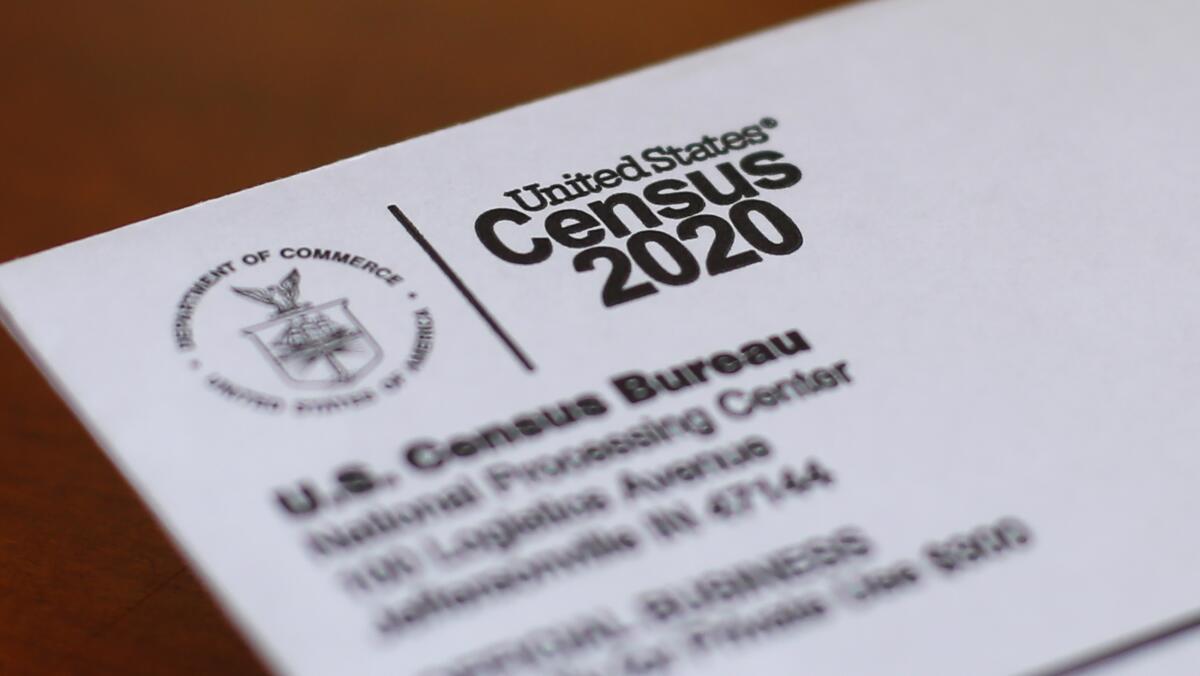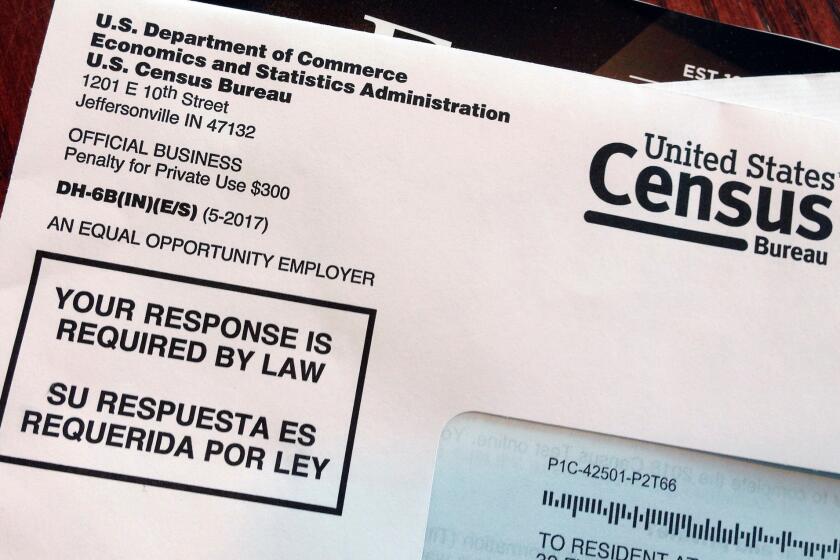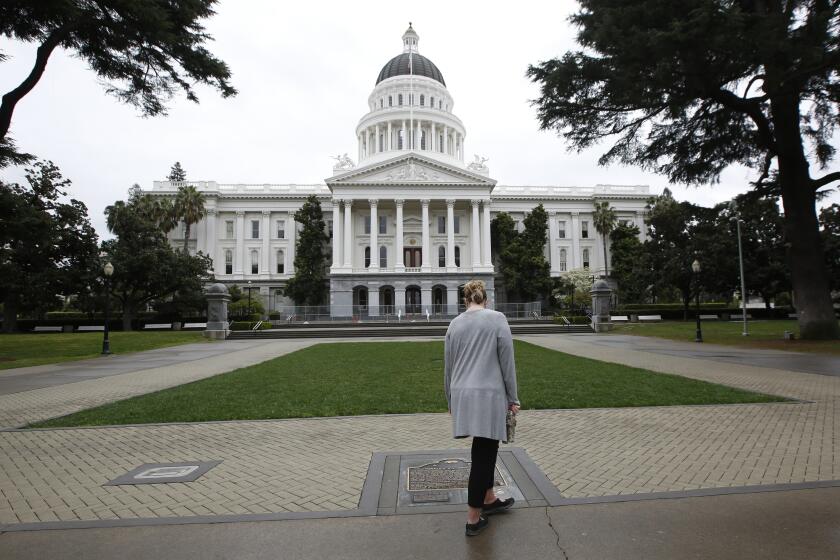U.S. population has become more diverse, 2020 census shows as redistricting frenzy begins

- Share via
The United States is more diverse than ever, with growing numbers of Latino, Asian and multiracial residents, while the white population saw a historic decline, a census report revealed Thursday, kicking off a frenzied push to redraw the nation’s political map.
The changing demographics provide the blueprint for carving the country into updated congressional and legislative districts. While the process has always been an exercise in consolidating power, it promises to be especially contentious because of the hyperpolarized political climate and compressed time frame before next year’s midterm election.
The results will lock in the political map until the 2030 census and, more immediately, set the stage for next year’s battle for control of the U.S. House of Representatives. With Democrats holding a narrow margin in the House, some analysts expect that Republicans could pick up enough seats just through partisan gerrymandering to win the majority in 2022.
The president, along with Vice President Kamala Harris, hopes to energize lackadaisical Democrats.
“Our analysis of the 2020 census results [shows] that the U.S. population is much more multiracial and more racially and ethnically diverse than what we have measured in the past,” said Nicholas Jones, director of race and ethnic research and outreach for the Census Bureau’s population division.
Although diversity increased throughout the country, the trend was especially pronounced in states where battles over redistricting are expected to be bruising. In Texas, for example, the white population outpaced the number of Latinos by more than 7% in 2010; now the two groups are practically equal in size. And white residents now make up narrow majorities in Georgia, Florida and Arizona, all states that have passed restrictive voting laws this year that have come under criticism for disproportionately affecting people of color.
White people remained the largest racial or ethnic group in the nation at 57.8% of the total. But there were more than 5 million fewer white people than there had been 10 years ago, marking the first time on record that their overall population shrank. Among those under 18, just 47% were white, auguring even more diversity in coming years.
The president, along with Vice President Kamala Harris, hopes to energize lackadaisical Democrats.
Latinos were the second-most-prevalent group, with 18.7% of the country’s residents. In California, the nation’s most populous state, Latinos were the largest ethnic group, making up nearly 4 in 10 residents.
Given the unprecedented circumstances of last year’s census — among them, a global pandemic and protracted legal fights over the Trump administration’s efforts to ask about citizenship status — some observers had fretted about the accuracy of the count, especially regarding Latinos.
“The concern was that it was going to be dramatically lower. It’s actually slightly higher,” said Kelly Ward Burton, executive director of the National Democratic Redistricting Committee, a liberal advocacy group. “That’s really good news, and I think a lot of people are pleasantly surprised by that.”
The findings, which had been delayed due to the pandemic, show the national population increasing by 7.4% over the last decade — the second-slowest rate of growth, after the Great Depression era, in the country’s history.
The first round of census data, released in April, revealed which states gained or lost seats in Congress based on their populations. The more granular information released on Thursday showed the slowdown in growth was particularly pronounced on the county level, with 52% of counties having fewer residents in 2020 than they did 10 years ago. Population increases were concentrated largely in metro areas.
“It’s clearly a favorable situation for Democrats,” said William Frey, a demographer with the Brookings Institution, pointing to the growth in urban and suburban areas, which tilt blue, as do people of color, whose numbers are growing. Republicans tend to do best among rural residents and white voters, both of which saw declines.
But political clout and representation are determined largely by how district lines are drawn, and for now the GOP has the edge. Republicans essentially control the map-drawing in 20 states, overseeing 187 House seats, according to the Associated Press, versus 75 seats in eight states for the Democrats. The remaining districts will be determined by independent commissions and states where power is split between the two parties. (Six states have only one district.)
Sophisticated mapping tools will aid both parties to maximize their advantage. But given that districts must be roughly equal in population size, there are limits to how creative line-drawers can be. In states that gained a congressional seat this year, such as Texas, Florida and North Carolina, it will be “much more difficult,” Frey said, for Republicans to find additional solidly conservative territory in light of urban and suburban growth.
It could take days or weeks for states, universities and political operatives to process the raw data into a user-friendly format.
California’s potential loss would drop the state’s seats in the U.S. House of Representatives from 53 to 52.
But the process of drawing maps got underway even without the population details, said Michael Li, a redistricting expert with the Brennan Center for Justice at NYU Law. There have been public meetings to get feedback on what changes communities would like to see in the districts, as well as strategizing behind closed doors.
“I guarantee you that in almost every state, partisan interests have gone ahead and started drawing maps,” Li said. “They’re trying to figure out what they can do and what they can get away with.”
Even with all the ongoing action, the Census Bureau’s data release on Thursday marked an important milestone, said Matt Rexroad, a Republican redistricting consultant based in Woodland, Calif.
“Those maps will start appearing to be more functional, because they have real data behind them. Suddenly, they’ll start to matter, so people will flip out even a little bit more,” he said.
With California losing a congressional seat for the first time in its history, many political observers are watching which region — and which incumbent politicians — may be disadvantaged by the new maps. The lost district is likely to come out of Los Angeles County, which grew at a slower pace than other parts of the state.
California’s independent redistricting panel may decide to reconfigure the 25th Congressional District around Santa Clarita, a swing seat represented by Republican Rep. Mike Garcia. Boundaries in Orange County could also change — including Democratic Rep. Katie Porter’s district, which includes Irvine, one of the nation’s 10 fastest-growing cities. The swell in residents means the district will have to shrink geographically to bring its population in line with other congressional districts.
The independent redistricting commission was created to stop secretive map drawing.
Much of the focus during redistricting is on Congress. But the new census data will also prompt the drawing of districts for the state Legislature, county boards of supervisors, city councils, water districts and other bodies that affect Californians’ day-to-day lives.
Those lines will be drawn with public input and map-drawing tools that are accessible to everyone at an unprecedented level, noted Paul Mitchell, a Sacramento-based Democratic redistricting expert, making it harder to simply protect incumbents.
“That’s going to be a big difference, and that’s going to affect people’s local government,” Mitchell said.
The state’s independent commission should release draft maps in late November. The final maps for Congress, the Legislature and the Board of Equalization are due to be completed around Christmas. The commission is asking the state Supreme Court to extend the deadline to Jan. 14.
“It’s an exciting day because we are receiving the much-awaited census data,” said Sara Sadhwani, an assistant professor of politics at Pomona College and one of 14 members of the California Citizens Redistricting Commission.
Although the panel must wait for UC Berkeley to format the data, “we can start planning out our process a little bit more clearly,” Sadhwani said.
Nationally, 18 states have either redistricting or election deadlines that require the maps to be completed by fall or early winter. An additional 14 are anticipated to wrap up their work by the end of this year, meaning that all told, a large majority of states will be scrambling to finalize new districts in just a few months.
Even after the maps are drawn, the power struggle is likely to continue in the courts. Multiple lawsuits have already been filed in anticipation of impasses over new lines in states where control is divided between Democrats and Republicans.
Legal challenges may be hobbled, however, by the U.S. Supreme Court’s 2019 decision that partisan gerrymandering was a political question, and therefore beyond the reach of federal courts.
“The Supreme Court’s decision has opened up the door to a lot of gerrymandering, which fits the moment in a lot of ways,” said Li, of the Brennan Center.
“I think people are scared. Politics feels existential, like a zero-sum game, and it’s particularly ominous for communities of color.”
More to Read
Get the L.A. Times Politics newsletter
Deeply reported insights into legislation, politics and policy from Sacramento, Washington and beyond. In your inbox three times per week.
You may occasionally receive promotional content from the Los Angeles Times.















